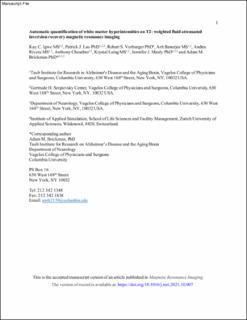Please use this identifier to cite or link to this item:
https://doi.org/10.21256/zhaw-23357Full metadata record
| DC Field | Value | Language |
|---|---|---|
| dc.contributor.author | Igwe, Kay C. | - |
| dc.contributor.author | Lao, Patrick J. | - |
| dc.contributor.author | Vorburger, Robert S. | - |
| dc.contributor.author | Banerjee, Arit | - |
| dc.contributor.author | Rivera, Andres | - |
| dc.contributor.author | Chesebro, Anthony | - |
| dc.contributor.author | Laing, Krystal | - |
| dc.contributor.author | Manly, Jennifer J. | - |
| dc.contributor.author | Brickman, Adam M. | - |
| dc.date.accessioned | 2021-10-30T12:33:20Z | - |
| dc.date.available | 2021-10-30T12:33:20Z | - |
| dc.date.issued | 2021-10 | - |
| dc.identifier.issn | 0730-725X | de_CH |
| dc.identifier.issn | 1873-5894 | de_CH |
| dc.identifier.uri | https://digitalcollection.zhaw.ch/handle/11475/23357 | - |
| dc.description | https://pubmed.ncbi.nlm.nih.gov/34662699/ | de_CH |
| dc.description.abstract | White matter hyperintensities (WMH) are areas of increased signal visualized on T2-weighted fluid attenuated inversion recovery (FLAIR) brain magnetic resonance imaging (MRI) sequences. They are typically attributed to small vessel cerebrovascular disease in the context of aging. Among older adults, WMH are associated with risk of cognitive decline and dementia, stroke, and various other health outcomes. There has been increasing interest in incorporating quantitative WMH measurement as outcomes in clinical trials, observational research, and clinical settings. Here, we present a novel, fully automated, unsupervised detection algorithm for WMH segmentation and quantification. The algorithm uses a robust preprocessing pipeline, including brain extraction and a sample-specific mask that incorporates spatial information for automatic false positive reduction, and a half Gaussian mixture model (HGMM). The method was evaluated in 24 participants with varying degrees of WMH (4.9-78.6 cm3) from a community-based study of aging and dementia with dice coefficient, sensitivity, specificity, correlation, and bias relative to the ground truth manual segmentation approach performed by two expert raters. Results were compared with those derived from commonly used available WMH segmentation packages, including SPM lesion probability algorithm (LPA), SPM lesion growing algorithm (LGA), and Brain Intensity AbNormality Classification Algorithm (BIANCA). The HGMM algorithm derived WMH values that had a dice score of 0.87, sensitivity of 0.89, and specificity of 0.99 compared to ground truth. White matter hyperintensity volumes derived with HGMM were strongly correlated with ground truth values (r = 0.97, p = 3.9e-16), with no observable bias (-1.1 [-2.6, 0.44], p-value = 0.16). Our novel algorithm uniquely uses a robust preprocessing pipeline and a half-Gaussian mixture model to segment WMH with high agreement with ground truth for large scale studies of brain aging. | de_CH |
| dc.language.iso | en | de_CH |
| dc.publisher | Elsevier | de_CH |
| dc.relation.ispartof | Magnetic Resonance Imaging | de_CH |
| dc.rights | http://creativecommons.org/licenses/by-nc-nd/4.0/ | de_CH |
| dc.subject | Automated segmentation | de_CH |
| dc.subject | Half Gaussian mixture model | de_CH |
| dc.subject | Mixture model | de_CH |
| dc.subject | Small vessel cerebrovascular disease | de_CH |
| dc.subject | White matter hyperintensity | de_CH |
| dc.subject.ddc | 616.8: Neurologie und Krankheiten des Nervensystems | de_CH |
| dc.title | Automatic quantification of white matter hyperintensities on T2-weighted fluid attenuated inversion recovery magnetic resonance imaging | de_CH |
| dc.type | Beitrag in wissenschaftlicher Zeitschrift | de_CH |
| dcterms.type | Text | de_CH |
| zhaw.departement | Life Sciences und Facility Management | de_CH |
| zhaw.organisationalunit | Institut für Computational Life Sciences (ICLS) | de_CH |
| dc.identifier.doi | 10.1016/j.mri.2021.10.007 | de_CH |
| dc.identifier.doi | 10.21256/zhaw-23357 | - |
| dc.identifier.pmid | 34662699 | de_CH |
| zhaw.funding.eu | No | de_CH |
| zhaw.originated.zhaw | Yes | de_CH |
| zhaw.pages.end | 79 | de_CH |
| zhaw.pages.start | 71 | de_CH |
| zhaw.publication.status | acceptedVersion | de_CH |
| zhaw.volume | 85 | de_CH |
| zhaw.embargo.end | 2022-10-16 | de_CH |
| zhaw.publication.review | Peer review (Publikation) | de_CH |
| zhaw.webfeed | Data Management & Visualisation | de_CH |
| zhaw.author.additional | No | de_CH |
| zhaw.display.portrait | Yes | de_CH |
| Appears in collections: | Publikationen Life Sciences und Facility Management | |
Files in This Item:
| File | Description | Size | Format | |
|---|---|---|---|---|
| 2021_Igwe-etal_Quantification-white-matter-hyperintensities.pdf | Accepted Version | 809.9 kB | Adobe PDF |  View/Open |
Show simple item record
Igwe, K. C., Lao, P. J., Vorburger, R. S., Banerjee, A., Rivera, A., Chesebro, A., Laing, K., Manly, J. J., & Brickman, A. M. (2021). Automatic quantification of white matter hyperintensities on T2-weighted fluid attenuated inversion recovery magnetic resonance imaging. Magnetic Resonance Imaging, 85, 71–79. https://doi.org/10.1016/j.mri.2021.10.007
Igwe, K.C. et al. (2021) ‘Automatic quantification of white matter hyperintensities on T2-weighted fluid attenuated inversion recovery magnetic resonance imaging’, Magnetic Resonance Imaging, 85, pp. 71–79. Available at: https://doi.org/10.1016/j.mri.2021.10.007.
K. C. Igwe et al., “Automatic quantification of white matter hyperintensities on T2-weighted fluid attenuated inversion recovery magnetic resonance imaging,” Magnetic Resonance Imaging, vol. 85, pp. 71–79, Oct. 2021, doi: 10.1016/j.mri.2021.10.007.
IGWE, Kay C., Patrick J. LAO, Robert S. VORBURGER, Arit BANERJEE, Andres RIVERA, Anthony CHESEBRO, Krystal LAING, Jennifer J. MANLY und Adam M. BRICKMAN, 2021. Automatic quantification of white matter hyperintensities on T2-weighted fluid attenuated inversion recovery magnetic resonance imaging. Magnetic Resonance Imaging. Oktober 2021. Bd. 85, S. 71–79. DOI 10.1016/j.mri.2021.10.007
Igwe, Kay C., Patrick J. Lao, Robert S. Vorburger, Arit Banerjee, Andres Rivera, Anthony Chesebro, Krystal Laing, Jennifer J. Manly, and Adam M. Brickman. 2021. “Automatic Quantification of White Matter Hyperintensities on T2-Weighted Fluid Attenuated Inversion Recovery Magnetic Resonance Imaging.” Magnetic Resonance Imaging 85 (October): 71–79. https://doi.org/10.1016/j.mri.2021.10.007.
Igwe, Kay C., et al. “Automatic Quantification of White Matter Hyperintensities on T2-Weighted Fluid Attenuated Inversion Recovery Magnetic Resonance Imaging.” Magnetic Resonance Imaging, vol. 85, Oct. 2021, pp. 71–79, https://doi.org/10.1016/j.mri.2021.10.007.
Items in DSpace are protected by copyright, with all rights reserved, unless otherwise indicated.